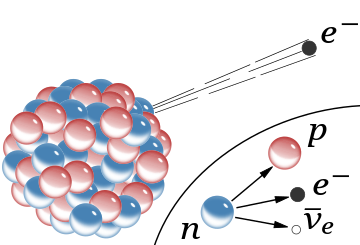
Back تآثر فيرمي Arabic Interacció de Fermi Catalan Fermi-Wechselwirkung German Constante de Fermi Spanish برهمکنش فرمی Persian Théorie de Fermi de la désintégration β French फर्मी अन्योन्यक्रिया Hindi Interazione di Fermi Italian フェルミ相互作用 Japanese Teoria Fermiego Polish

β−
decay in an atomic nucleus (the accompanying antineutrino is omitted). The inset shows beta decay of a free neutron. In both processes, the intermediate emission of a virtual
W−
boson (which then decays to electron and antineutrino) is not shown.
In particle physics, Fermi's interaction (also the Fermi theory of beta decay or the Fermi four-fermion interaction) is an explanation of the beta decay, proposed by Enrico Fermi in 1933.[1] The theory posits four fermions directly interacting with one another (at one vertex of the associated Feynman diagram). This interaction explains beta decay of a neutron by direct coupling of a neutron with an electron, a neutrino (later determined to be an antineutrino) and a proton.[2]
Fermi first introduced this coupling in his description of beta decay in 1933.[3] The Fermi interaction was the precursor to the theory for the weak interaction where the interaction between the proton–neutron and electron–antineutrino is mediated by a virtual W− boson, of which the Fermi theory is the low-energy effective field theory.
According to Eugene Wigner, who together with Jordan introduced the Jordan–Wigner transformation, Fermi's paper on beta decay was his main contribution to the history of physics.[4]
- ^ Yang, C. N. (2012). "Fermi's β-decay Theory". Asia Pacific Physics Newsletter. 1 (1): 27–30. doi:10.1142/s2251158x12000045.
- ^ Feynman, R.P. (1962). Theory of Fundamental Processes. W. A. Benjamin. Chapters 6 & 7.
- ^ Griffiths, D. (2009). Introduction to Elementary Particles (2nd ed.). pp. 314–315. ISBN 978-3-527-40601-2.
- ^ Fermi, Enrico (2004). Fermi Remembered. University of Chicago Press. p. 241-244. ISBN 0226121119. Edited by James W. Cronin.
© MMXXIII Rich X Search. We shall prevail. All rights reserved. Rich X Search